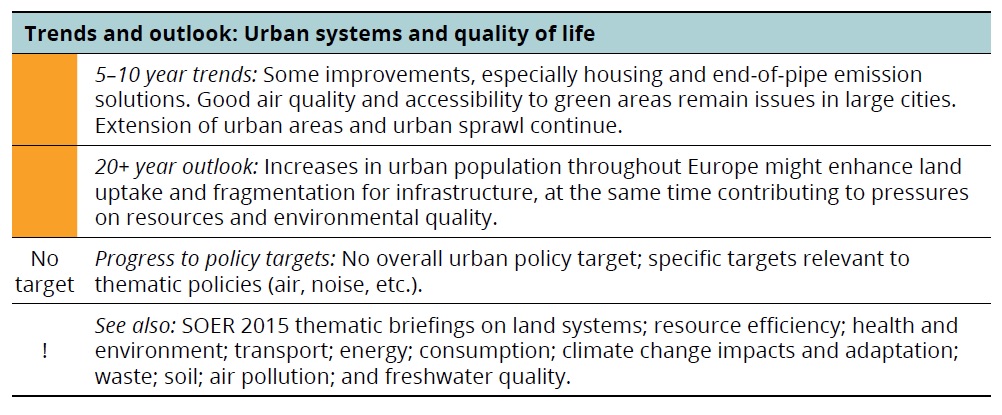Origen: 5. Safeguarding people from environmental risks to health — EEA
Nearly 73% of the European population lives in cities, and this is projected to reach 82% in 2050 (UN, 2011; 2012b). Urban development in Europe, particularly the increasing trend in peri-urbanisation, can increase pressures on the environment and human health, for example through landscape fragmentation and air emissions from transport (EEA, 2006; IPCC, 2014a) (see also Section 4.10).
Environmental impacts on human health and well-being are particularly pronounced in urban settings where multiple pressures coexist. This can affect large populations, including vulnerable groups, such as the very young and the elderly. Potential exacerbation of those impacts due to climate change points to a need for dedicated adaptation actions.
On the other hand, compact urban development and more resource-efficient approaches to the built environment provide opportunities to alleviate environmental pressures and enhance human well-being. In addition, well planned urban areas providing easy access to natural, green environments may deliver health and well-being benefits, including protection from the impacts of climate change (EEA, 2009a, 2012i; EEA/JRC, 2013).
The proportion of urban green space differs between European cities (Map 5.2). However, the actual use of green spaces depends critically on their accessibility, quality, safety, and size. There are also marked cultural and socio-demographic variations in the perception of green space and attitudes towards its use (EEA/JRC, 2013).

The importance of urban green spaces for human health and well-being is increasingly recognised, partly due to better understanding of ecosystem services (Stone, 2009; Pretty et al., 2011). The benefits of high quality green environments to physical health, mental and social well-being, and improved quality of life can be substantial, although the nature of these interactions is not fully understood (EEA/JRC, 2013; Depledge and Bird, 2009; Greenspace Scotland, 2008; Paracchini et al., 2014). Fragmentary evidence indicates that access to green environments contributes to reducing (income-related) health inequalities (Mitchell and Popham, 2008; EEA/JRC, 2013).
The EU Green Infrastructure Strategy (EC, 2013b), and improved approaches to spatial analysis (EEA, 2014u), can contribute to assessing the trade-offs and co-benefits of urban development. Efforts to promote innovative urban policies for healthier, denser, greener and smarter cities are under way, for example by designating cities as European Green Capitals (EC, 2014g).
Multifunctional green infrastructure plays a role in urban adaptation to climate change, affecting temperature regulation, increased biodiversity, protection against noise, reduction of air pollution, prevention of soil erosion, and prevention of flooding (EC, 2013b; EEA, 2012i). The early integration of adaptation measures, including green infrastructure, into urban planning can offer long-term, cost-effective solutions. However, such measures are not yet widely implemented (EEA, 2012i; IPCC, 2014a) (see also Section 5.7).
Further implementation of policies for sustainable urban planning and design is crucial to enhance the sustainability of EU cities (EU, 2013). Smart planning and governance mechanisms can influence mobility patterns towards more sustainable forms of transport and reduced transport demand. They can also enhance the energy efficiency of buildings, reducing environmental pressures and improving well-being at the same time (EEA, 2013a, 2013f).



 Aragonese
Aragonese English
English Spanish
Spanish